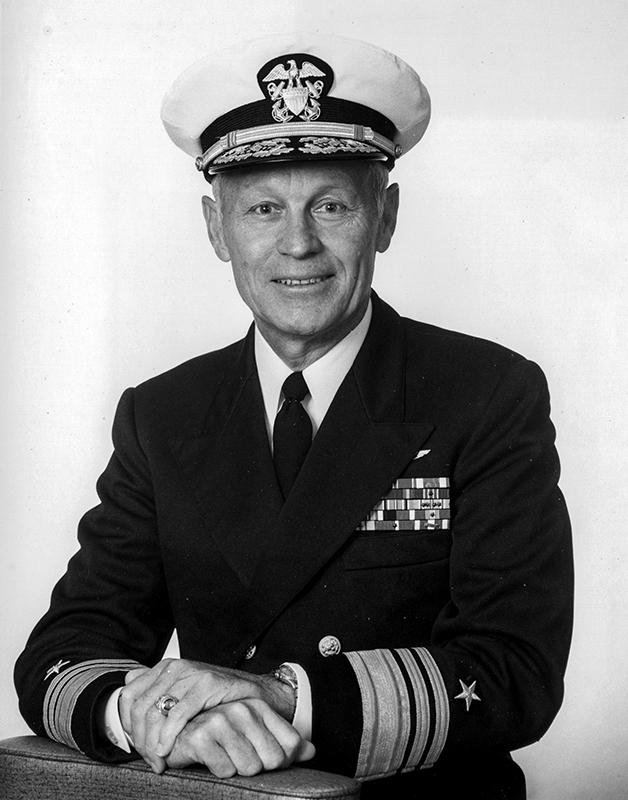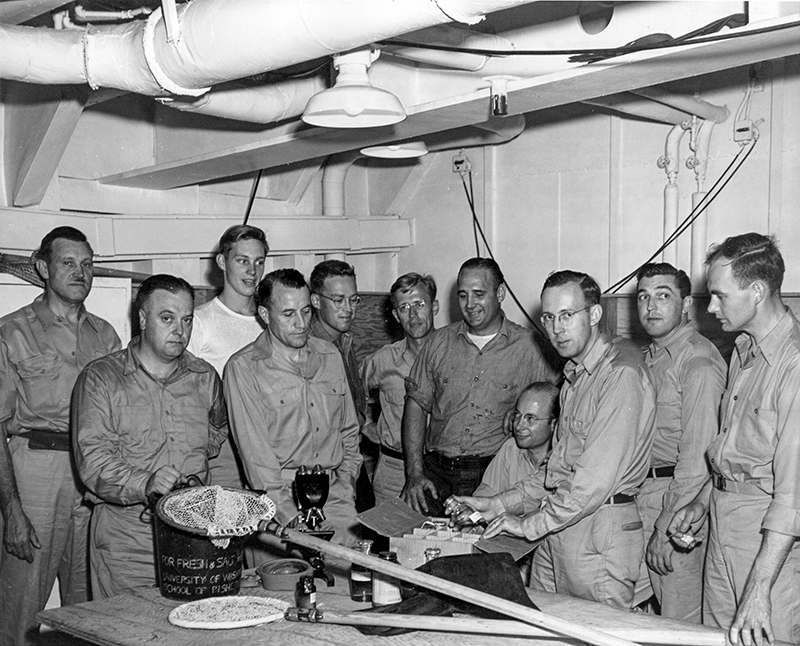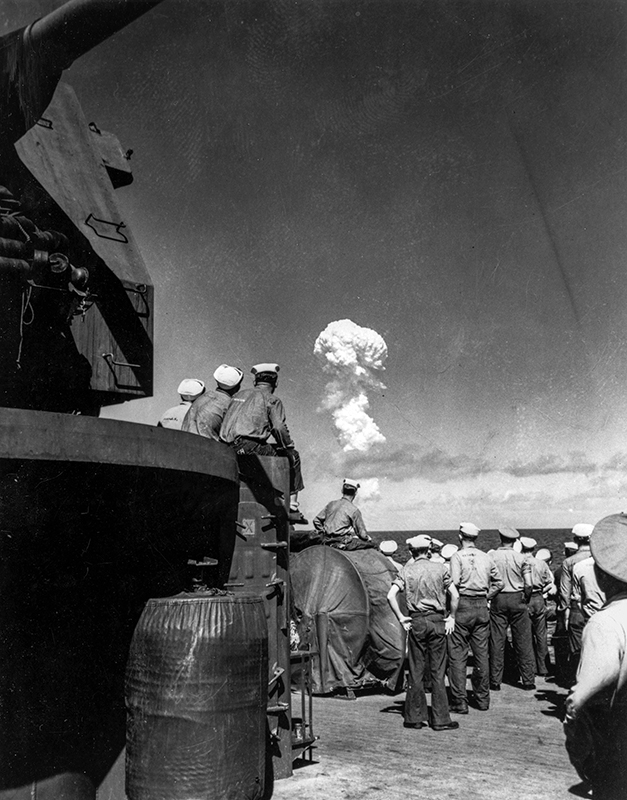
Forbes, Bernard B. Jr., Vice Adm., USN (Ret.)
(1920–2002)
Bernard "Beetle" Forbes was a skilled naval aviator and gifted storyteller. Following his graduation from the Naval Academy, he served in the destroyer USS Barton (DD-722), 1944-47, including combat duty in the Pacific. He was briefly commanding officer of the patrol craft USS PC-572 before going through flight training, 1947-49. His first fleet assignment as an aviator was in Composite Squadron 33 (VC-33). He served twice as flag lieutenant to Admiral Felix B. Stump, initially when Stump was ComNavAirLant and Commander Second Fleet, later when Stump was CinCPacFlt/CinCPac. Sandwiched between was Forbes' duty as flight instructor, 1953-55. Subsequent tours included Attack Squadron 15 (VA-15), postgraduate education at Stanford University, and the senior course at the Naval War College. In the early 1960s Forbes commanded Attack Squadron 176 (VA-176), served as air officer of the attack aircraft carrier USS Franklin D. Roosevelt (CVA-42), and was in the manpower section, OP-103, on the OpNav staff. During his time flying AD Skyraiders in attack squadrons, he trained for possible delivery of nuclear weapons. He commanded the ammunition ship USS Shasta (AE-6) during a 1966-67 Vietnam deployment. From 1967 to 1969 he was a detailer in the Bureau of Naval Personnel, and then commanded the attack aircraft carrier USS Independence (CVA-62), which deployed to the Mediterranean. Duties in the early 1970s were as chief of staff to Commander Sixth Fleet, head detailer in the Bureau of Naval Personnel, and command of Carrier Group Six and Carrier Group Two. His final active duty was as Deputy Commander in Chief Atlantic/Deputy Commander in Chief Atlantic Fleet. The oral history contains a number of personal insights on Admiral Isaac C. Kidd Jr., for whom Forbes served in both Sixth Fleet and the Atlantic Fleet
Interview
In this selection from his first interview with Paul Stillwell at the U.S. Naval Institute on 27 December 1991, Admiral Forbes discusses his experiences on board the USS Barton (DD-722) in 1946, during the Bikini Atomic Bomb tests of Operation Crossroads.
Admiral Forbes: From December 24, 1945, until January 3, 1946, I had the duty, solid, on that destroyer. Oh, well. It was great. I really enjoyed my destroyer duty.
Paul Stillwell: What sort of a mission did the ship have after the war ended?
Admiral Forbes: Okay. We got a quick overhaul and had everything fixed up. Then we were chosen—all the classification has been taken away now, I'm sure—to be the ship to take the atomic weapons out to Bikini for those tests.[1] The skipper knew it. He got me up, and I was briefed by the people. We had these senior people on board, and then an Army group came on board in uniform. This is later on. Then we received the bomb itself—not just the fuselage of the bomb, but the brains, the innards, the nuclear component part, which they stowed in one of the staterooms, and we had this special Army team of guards.
It was Bill Polhemus’s room; he had to move out. I said, "Bill, we're just boot ensigns. These people are senior to us, and that's why they're taking your room."
"Okay, okay. I guess that's the way it goes."
I knew why they were there. The weapons were there, secured under the bunk; they weren't very big. They had two of those people on guard 24 hours a day, on a Navy ship at sea. Once Bill forgot about the guards. He explained to me, "Hey, Rabbit, I went to get the shirt I forgot, and some guy stuck a .45 right in my face."
I said, "Well, you know how those Army types are. They don't know what's going on." And we both laughed. He laughed with me, and we dismissed it that way. When we got to Bikini, we very carefully unloaded it. Of course, the crew knew that that big thing up on the boat deck was the body of the bomb; we didn't make any bones about that. And, I'll never forget, we had to have the exact depth of water in the sound, in case anything dropped over the side. Then we were the closest ship to the actual explosions.
Well, now, I'll have to digress for a moment. We arrived there days before they had the actual bomb drop, because they had to reassemble the components. So while the preparations were being completed, we found out that this was the breeding ground of the yellowfin tuna out there in that atoll. They wondered if the bomb blast would have any effect on the fish.
There was an old World War I minesweeper on station. It was one of these old, old buckets. A classmate of mine was skipper of this ship, and he had—I learned the word for the first time—an ichthyologist on board from San Diego. They cruised around the atoll fishing, and they'd log the kind of fish they caught and the sex and all that. Everything was very proper. I got permission to visit the ship one day while Barton was anchored. I'd never caught so many fish in my life. We saw gear carried away. These were great big yellowfin tuna. I'll jump ahead and say fortunately it had no effect on them.

As I said, we were the closest ship to the drop point. I'll never forget when that big bomber came over and dropped that thing.[2] We had the people on board; we had the special camera on our fire-control radar. I'd helped them with that. I said, "Why don't you just mount it on my fire control radar?" We just tracked that bomb right down. Oh, it was great. We just tracked it in till it exploded. We got all the pictures for them.
After that we steamed downwind and chased that cloud for I've forgotten how many—oh, it seemed like forever. We then came back and took water samples every so often. That's when we caught so many sharks. We came back and were there for the underwater explosion which, you know, really didn't hurt the fishing either, as they later found out. Then we returned to the States. The services were being cut back. I'd been promoted to executive officer then.
Paul Stillwell: Was there any monitoring to see if you'd been exposed to radiation?
Admiral Forbes: Yes. For years after that, I had to go every so often for a complete physical and I'd get these letters from on high about what they'd found and all this, that and the other.
Paul Stillwell: Was there any effect?
Admiral Forbes: No. And I was the one who was with those tests all of the time.
[1] In July 1946 a joint Army-Navy task force conducted tests at Bikini Atoll in the Marshall Islands to determine the effects of atomic bombs on moored warships. Along with an array of U.S. ships were captured German and Japanese warships.
[2] Operation Crossroads involved the testing by U.S. forces of two atomic weapons, detonated at Bikini Atoll in the Marshall Islands on 1 July and 25 July 1946.
About this Volume
Based on two interviews conducted by Paul Stillwell in December 1991 and February 1992, the volume contains 239 pages of interview transcript plus a comprehensive index. The transcript is copyright 2007 by the U.S. Naval Institute; the interviewee placed no restrictions on its use.




